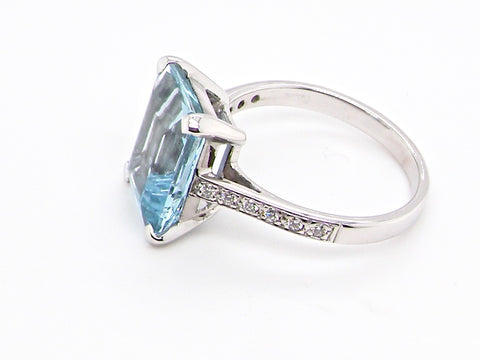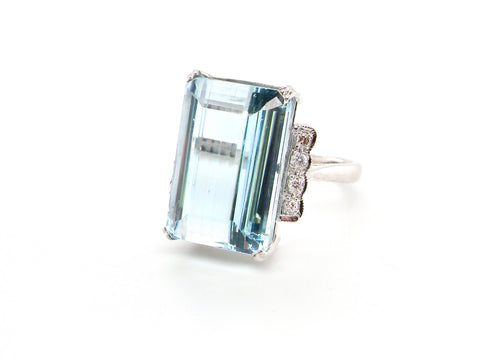The History of Aquamarine: A Gemstone of the Sea
The first aquamarine I ever handled was set in an Art Deco ring. The stone was a pale, icy blue, framed by sharp white gold lines that gave it an almost architectural feel. When I tilted it under the light, it seemed to glow like sunlight hitting water. It wasn’t a large stone, but it had a presence calm, soothing, and quietly elegant.
That’s the charm of aquamarine. Unlike the fiery drama of rubies or garnets, aquamarine has always spoken in softer tones. At Charles Hart Jewellers, our family has been trading in fine jewellery for over 200 years, and we’ve seen aquamarine appear in everything from Georgian pendants to Edwardian necklaces and bold mid-20th-century cocktail rings. Each piece reflects how this gemstone’s cool beauty has been admired through the centuries.

Aquamarine in the Ancient World
The name “aquamarine” comes from the Latin words aqua marina “water of the sea.” Fittingly, sailors once carried aquamarine as a talisman for safe passage. The Greeks believed it could calm the waves, while the Romans thought it brought good fortune to married couples. I once handled an antique intaglio cut from aquamarine in the Roman style, carved with a family crest. Even though it was much younger than the original Roman pieces, it was a reminder that this gemstone has always been linked to the sea and to protection.

Aquamarine in the Middle Ages
By the medieval period, aquamarine had become a favourite among nobility and clergy. Its clear, almost glass-like appearance was thought to symbolise purity and truth. Some believed it could act as a mirror of honesty if you held it up during disputes, the guilty party could not hide their lies. These symbolic associations meant aquamarine was often chosen for reliquaries and ecclesiastical jewellery. To collectors today, those stories add a layer of fascination beyond the gemstone’s beauty.
Aquamarine in the 19th and 20th Centuries
In the 1800s, larger deposits of aquamarine were discovered in Brazil, and the stone’s popularity soared. Georgian and Victorian jewellers favoured aquamarine for pendants and brooches, often cutting it into elongated rectangular shapes to emphasise its clarity.
By the Art Deco period, aquamarine became the centrepiece of bold, geometric designs. We once sold a striking 1930s cocktail ring featuring a rectangular aquamarine flanked by diamond baguettes. The crisp lines and icy colours made it feel as fresh and modern today as it must have looked nearly a century ago.
What Makes Aquamarine Special to Collectors
• Colour: The most prized aquamarines are a strong blue, sometimes with a greenish tint, though softer sky-blues are also admired.
• Clarity: Aquamarine is usually very clear, with few inclusions part of its appeal.
• Durability: With a hardness of 7.5–8 on the Mohs scale, it’s tough enough for rings and daily wear.
• Affordability: Compared to sapphires, aquamarines are relatively accessible, making them a popular choice for collectors starting their journey.
FAQs About Aquamarine
Q: Is aquamarine valuable?
A: Yes, especially when it’s large, richly coloured, and well-cut. Brazilian stones are highly prized. That said, aquamarine is more affordable than sapphires, which makes it attractive to collectors looking for statement pieces without the sapphire price tag.
Q: Why is aquamarine linked to the sea?
A: The name itself means “water of the sea,” and throughout history the stone has been tied to sailors, safe travel, and calm waters. Its colour alone explains why the association stuck.
Q: Is aquamarine a birthstone?
A: Yes, aquamarine is the birthstone for March. Antique aquamarine rings are a particularly meaningful gift for March birthdays.
Q: How should I care for aquamarine jewellery?
A: Clean gently with warm water and a soft brush. Avoid ultrasonic cleaners, especially for antique pieces where the setting may be delicate. Store separately to prevent scratching.
Q: What styles of antique aquamarine jewellery are most collectable?
A: Georgian and Victorian pendants, Edwardian lavaliere necklaces, and Art Deco cocktail rings are especially popular with collectors
Final Thoughts
Aquamarine has always carried a quiet kind of magic. From sailors’ amulets to Art Deco cocktail rings, it has been treasured for its cool elegance and calming presence. It may not shout like a ruby or sparkle as fiercely as a diamond, but aquamarine has its own voice one that has resonated for centuries. At Vintage Tom, we take pride in sourcing antique aquamarine jewellery that reflects both beauty and history. Each piece is a little reminder of the sea, captured in stone, and preserved for generations to come.
👉 Explore our collection of antique aquamarine jewellery and discover why this gemstone continues to enchant collectors.
You may also like: Antique Jewellery Investment Guide



